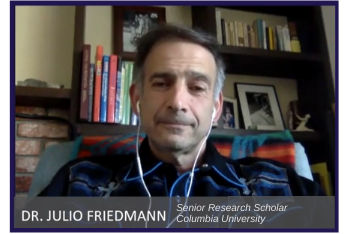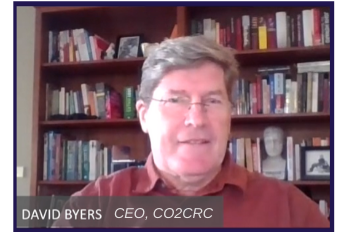Although global greenhouse gas emissions (GHG) may have temporarily dropped in 2020 as a result of the drastic changes in human behaviour due to the COVID-19 pandemic, the threat posed by climate change, and the commitments to tackle it, remain a major global priority. As national and local economies look to recover from the impacts of the global health crisis, the development and expansion of clean energy technologies have an opportunity to play a significant role in stimulating economic growth while supporting the crucial transition to a cleaner energy economy.
When the world first began to feel the impacts of the coronavirus crisis, Fatih Birol, the Executive Director for International Energy Agency (IEA), stated that governments must put clean energy transitions at the centre of stimulus plans and not lose sight of these efforts despite the challenging market conditions. Birol’s more recent opening remarks at the IEA Clean Energy Transitions Summit reiterated the notion that sustainable economic recovery, boosting economic growth, and clean energy transitions – can and must go hand in hand.
In a virtual discussion series, Lead. Care. Adapt, hosted by International CCS Knowledge Centre (Knowledge Centre) VP of Strategy and Stakeholder Relations, Beth (Hardy) Valiaho, along with ten industry and climate action experts, offered unique perspectives on what governments, investors, business leaders, and others can do to accelerate clean energy transitions to achieve economic sustainability during COVID- 19 and beyond.
Central ideas emerging from this experts series revolved around the importance of strong global leadership in the form of progressive government incentives, and policies to encourage rapid deployment of clean energy technologies. Many of these insights echo the IEA’s Sustainable Recovery – World Energy Outlook Special Report released in July 2020, which highlights the important role of carbon capture, utilization and storage (CCS/CCUS) technologies in the development of sustainable and resilient energy systems needed to support a sustainable exit strategy from the economic crisis.
CATALYZING DECARBONIZATION

A global authority on the intersection of markets and climate change, Katie Sullivan, the Managing Director of the International Emissions Trading Association (IETA), points out that the current global crisis is seen by many organizations and businesses as a “window to not return to the dirtier business as usual, but to catalyze decarbonization” while supporting a just transition toward an environmentally sustainable economy; noting the importance of recognizing this catalyst and ensuring it is utilized to scale decarbonization efforts in a positive and efficient manner.
As noted throughout the experts series, investment in both the development and deployment of CCS can help to increase the sustainability of necessary production and generation from heavy-emitting energy and industrial sources. CCS, among many other clean energy projects and initiatives, are also sound strategies for job creation as these sectors employ a range of workers in the areas of construction, consulting, engineering, skilled labour, and other specialities. Stimulating growth in these sectors also creates other much-needed economic spinoff during uncertain times.

With a global experience view as a lead negotiator for CCS considerations at Conference of the Parties (COP), Tim Dixon, the program manager for the IEA Greenhouse Gas program (IEAGHG), also highlights that these efforts help make the just transition from traditional employment to the “low carbon jobs of the future,” which he deems are sustainable, long term, opportunities that are a “win in the economy” and a “win in infrastructure.” Although the CCS process can take several years to implement and optimize, Dixon acknowledges that a lot of the work required to get CCS projects shovel-ready can be done in the short term and can contribute to economic stimulus. This includes: carbon dioxide (CO2) storage site identification and appraisals, transportation options, Feasibility and Front End Engineering Design (FEED) studies. Additionally, Dixon emphasizes the importance of partnership building for bringing together industry clusters of CCS.

Dr. Niall Mac Dowell, a researcher in energy systems for the Clean Fossil & Bioenergy Research Group at Imperial College London, agrees that now is the time to act on climate ambitions with large-scale emissions reductions technologies, such as CCS, at the forefront.
“In order to deploy these technologies at scale, we need concepts that are available today . . . CCS has a key and enduring role to play in decarbonizing both the power and the industrial sectors.”
Mac Dowell also considers technologies such as Bioenergy with CCS (BECCS) of great importance for tackling the residual emissions from the hard-to-abate sectors that are more challenging and costly to unlock.
HARD-TO-ABATE SECTORS
The cement industry, which represents 7-8% of global emissions, is an example of a hard-to-abate sector that produces these residual emissions from the manufacturing of concrete – an essential material for economic recovery and ongoing development in the construction industry.

Oil and Gas – another hard-to-abate sector, experienced its fair share of turbulence with the unexpected drop in oil prices due to the coronavirus outbreak, which was accelerated by the collapse of Organization of the Petroleum Exporting Countries (OPEC+). Similar to the cement industry, Dr. Julio Friedmann, Senior Research Scholar and Lead of Carbon Management Research Initiative (CaMRI) at Columbia University, claims that many companies in this sector have also remained strongly committed to CCS; proceeding with projects and investments into new business units.

Friedmann observes that the groups most inclined to invest in CCUS are oil and gas companies who see the technology as “part of their estate and part of their future,” noting how he has come across commercial gas, hydrogen, and chemical companies, who view these record low prices as an opportunity to be taken advantage of in the near term, despite decreased demand.
CLIMATE INVESTMENTS AND INCENTIVES

OGCI-CI is also interested in creating CCS hub and cluster networks which are bringing together multiple CO2 emitters and/or storage locations using shared transportation infrastructure. These large infrastructure projects reduce costs and risks for potential CCS projects and are vital to decarbonizing industry while supporting sustainable development – a major driving force for economic growth.
GLOBAL DEPLOYMENT
By accelerating CCS deployment, along with other clean energy technologies, there are several actionable measures policymakers and businesses can take to make quick and informed decisions to ensure countries have access to reliable energy, as well as electricity, which was a major priority underscored by the coronavirus pandemic for powering essential medical equipment.
Well-versed across the global oil, gas, and minerals industry, Australia’s David Byers, the CEO of CO2CRC, sees opportunities for clean energy technologies, like CCS, in places that have seen a lot of new development in electricity generation.

Byers says positive economic growth in Australia will be driven largely by international markets and trade, but domestically, he is optimistic that government will place economic value on the geological sequestration of CO2 emissions for the purpose of accruing carbon tax credits. As for emissions reductions throughout the rest of the world, he points to the expansion of the power generation sector as a prime area of focus.

As emerging nations build more resilient energy systems and economies, while also adapting to the adverse effects of climate change, Romanak perceives a country’s understanding and awareness of their potential for CCS as a central component to seeing these much-needed energy transitions take place in these regions.
“It’s important that they know that there are funding sources within the United Nations Framework Convention on Climate Change that can help them build CCS . . . it’s also important that they understand that there are international bodies that can support them . . . we want to be able to work with developing countries to help them on that journey and to implement CCS if it’s right for them.”
CLIMATE TARGETS
In terms of economic climate ambitions that were in place prior to the pandemic, including reaching net zero emissions, Sullivan says that this transition is still achievable, affordable, and realistic. She highlights that net zero allows for residual emissions, which can be addressed by different policy structures and market tools, including carbon offsetting and GHG removal.
“This is where bio sequestration – so forestry and agriculture, land use management, geo sequestration, CCUS, comes into play in a very, very big way. It’s why driving these renewables at scale become so critical to the future decarbonization pathways and it’s also why these flexible market mechanisms signals for business to invest in these renewables at scale – and do it sooner rather than later – becomes just so vital to this.”
The Intergovernmental Panel on Climate Change (IPCC) Global Warming of 1.5C Report shows that achieving net zero would be extremely challenging, if not impossible, without CCS – an essential technology necessary for carbon dioxide removal in three of the four IPCC pathways to reach climate neutrality by 2050.
MacDowell also agrees that net zero is a strong option that offers a “balanced portfolio approach” for economies to conserve value, and like many other energy and industry experts mention, the importance of rapidly deploying technologies to improve energy efficiency and deploy renewables will also be necessary to achieve crucial climate targets.
EXPERTISE AND LEADERSHIP

The coronavirus crisis has taught the world the importance of making major decisions over a short period. “Climate change action could benefit from such decisiveness,” notes Beth (Hardy) Valiaho. Post-pandemic, many decisions will also need to be made with the help of trusted advisors in government, energy, industry, and the climate action space. Policy makers must ensure businesses and workers can make the investments necessary to rapidly accelerate progress on clean energy and economic growth.
Over the next several years, many countries will be challenged to have the capacity to stimulate their economies. Strong global leadership will be more important than ever to ensure vulnerable populations have a reliable energy supply chain – an area where CCS must play a supporting role.
Friedmann thinks that one of the greatest lessons learned from the global health crisis is that there is no substitution for expertise. “We have to get roaring forward again . . . hopefully, the people who are making these decisions will trust the wide set of experts who agree that carbon management is part of the job.”

He sees energy efficiency and retrofits of commercial and residential buildings as “a massive opportunity” to train people and provide new jobs and stimulate the economy. He is also an advocate for clean technology companies – start-ups in particular – which he says require an injection of funding and supportive policy levers to encourage business growth by helping to increase productivity and expand exports to “re-kickstart” suffering operations.
The adoption of new clean technology is another vital driver of economic growth and competition that has the potential to boost innovation and efficiency. Many of the larger companies and industry sectors rely on environmental and clean tech goods and services provided by emerging cleantech firms.

Regardless of what decisions are ultimately made by governments worldwide during these unprecedented times, the climate change crisis will continue to be a global priority that must also be addressed in the near term. With the wealth of learnings and proven results from clean energy technologies as powerful and far-reaching as CCS – mitigating the impact and extent of one crisis can very well be a major strategy in another.
Hear more from these experts in the International CCS Knowledge Centre’s Lead. Care. Adapt. videos series.
